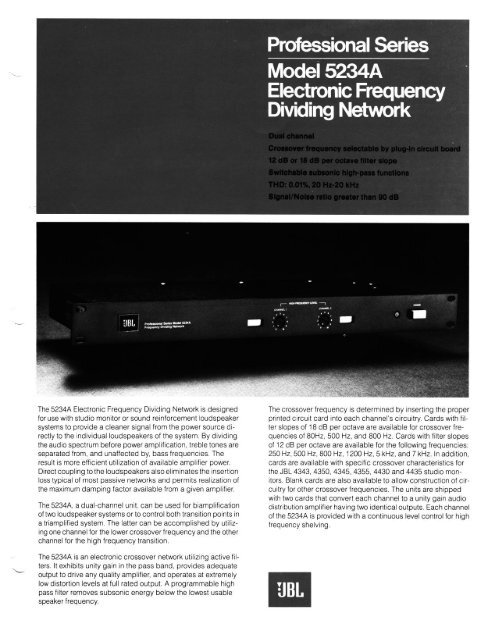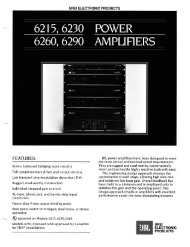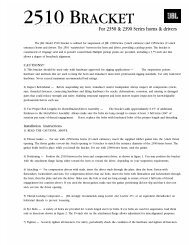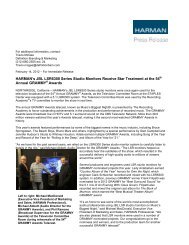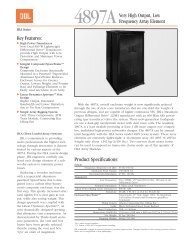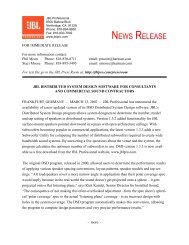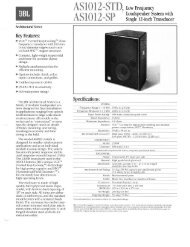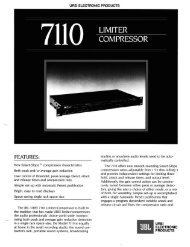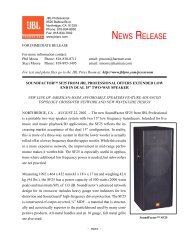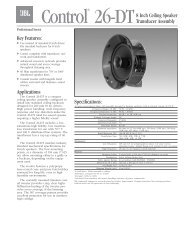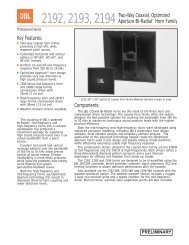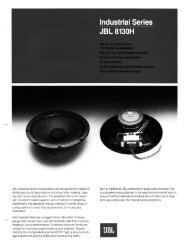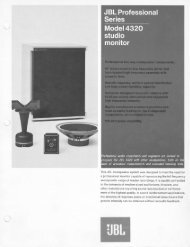Model 5234A Electronic Frequency Dividing ... - JBL Professional
Model 5234A Electronic Frequency Dividing ... - JBL Professional
Model 5234A Electronic Frequency Dividing ... - JBL Professional
Create successful ePaper yourself
Turn your PDF publications into a flip-book with our unique Google optimized e-Paper software.
-<br />
The <strong>5234A</strong> <strong>Electronic</strong> <strong>Frequency</strong> <strong>Dividing</strong> Network is designed<br />
for use with studio monitor or sound reinforcement loudspeaker<br />
systems to provide a cleaner signal from the power source di-<br />
rectly to the Individual loudspeakers of the system. By dividing<br />
the audio spectrum before power amplrfrcation, treble tones are<br />
separated from, and unaffected by, bass frequencies. The<br />
result is more efficrent utilization of available amplifier power.<br />
Direct coupling to the loudspeakers also eliminates the insertion<br />
loss typical of most passive networks and permits realization of<br />
the maximum damping factor available from a given amplifier.<br />
The <strong>5234A</strong>, a dual-channel unit, can be used for biamplification<br />
of two loudspeaker systems or to control both transition points in<br />
a tnamplifred system. The latter can be accomplished by utiliz-<br />
ing one channel for the lower crossover frequency and the other<br />
channel for the high frequency transition.<br />
The <strong>5234A</strong> IS an electronic crossover network utilrzrng active filters<br />
It exhibits unity gain in the pass band, provides adequate<br />
output to drive any quality amplifier, and operates at extremely<br />
low distortion levels at full rated output. A programmable high<br />
pass filter removes subsonic energy below the lowest usable<br />
speaker frequency.<br />
The crossover frequency is determined by inserting the proper<br />
printed circuit card into each channel’s circuitry. Cards with fil-<br />
ter slopes of 18 dB per octave are available for crossover fre-<br />
quencies of 80H.z 500 Hz, and 800 Hz. Cards with filter slopes<br />
of 12 dB per octave are available for the following frequencies;<br />
250 Hz, 500 Hz, 800 Hz, 1200 Hz, 5 kHz, and 7 kHz. In addition,<br />
cards are available with specific crossover characteristics for<br />
the <strong>JBL</strong> 4343,4350,4345,4355,4430 and 4435 studio mon-<br />
itors Blank cards are also available to allow construction of cir-<br />
cuitry for other crossover frequencies. The units are shipped<br />
with two cards that convert each channel to a unity gain audio<br />
distribution amplifier having two identical outputs. Each channel<br />
of the <strong>5234A</strong> is provided with a continuous level control for high<br />
frequency shelving.
<strong>Model</strong> <strong>5234A</strong> <strong>Electronic</strong> <strong>Frequency</strong> <strong>Dividing</strong> Network<br />
Architectural Specifications<br />
The sound system described herein shall be equipped with separate<br />
power amplifiers for low (midrange) and high frequency program<br />
material. A dual-channel low-level active network shall be provided<br />
to filter program material at the designated crossover point(s).The<br />
inputs shall be transformerless, symmetrical and floating. Dual-in-line<br />
switching shall provide selectable low frequency equalization and<br />
subsonic filtering.The frequency dividing network shall be equipped<br />
with separate output buffer amplifiers for low and high frequency<br />
program material.<br />
Crossover frequency selection shall be accomplished by internally<br />
mounted plug-in circuit modules. Each module shall be designed<br />
with the crossover frequency printed in such a position as to be<br />
easily read through a window In the front panel of the electronic<br />
frequency dividing network. The designated crossover frequency<br />
shall be the point at which the slopes of the pass band curves cross<br />
and where each is 3 dB down from the average output level.This<br />
point.shall be within -+ 10% of the designated frequency. The filter<br />
slope shall be 12 dB or 18 dB per octave.<br />
The unmodified frequency response of the dlvidlng network shall<br />
be 20 Hz-20 kHz, to.5 dB. DistortIon shall be less than 0.03% THD<br />
at + 18 dB, and 0.01% THD, + 18 dBv into a 100 kn load. Signal-to-<br />
noise ratio shall be greater than 90 dB at rated output, 20 Hz-20 kHz<br />
eaulvalent bandwldth.<br />
Internal provisIon shall be made for switch selectlon of parallel<br />
monaural low frequency outputs A high pass filter with 12 dB per<br />
octave slope shall remove subsonlc energy below the lowest usable<br />
speaker frequency A dual In-line switch shall provide the following<br />
programmable options for the subsonlc filter<br />
a Flat frequency response<br />
b 20 Hz hlg h pass filter, 12 dB/octave slope, Q = 0 707 (Butterworth)<br />
c 20 Hz high pass filter, 12 dB/octave slope, Q = 2 (6 dB boost<br />
@ 20 kHz)<br />
d 30 Hz high pass filter, 12 dB/octave slope, Q = 0 54<br />
e 30 Hz high pass filter, 12 dB/octave slope, Q = 0 84<br />
f 30 Hz high pass filter, 12 dB/octave slope, Q= 2 (6 dB boost<br />
@ 30 Hz)<br />
g 40 Hz hlg h pass filter 12 dB/octave slope, Q = 0 707 (Butterworth)<br />
h 40 Hz high pass filter, 12 dB/octave slope, Q= 2 (6 dB boost<br />
@ 40 Hz)<br />
Isolation between channels shall be greater than 70 dB.<br />
The electronic crossover network shall be a <strong>JBL</strong> <strong>5234A</strong><br />
Input and output terminals for the <strong>5234A</strong> The dual channels can be utlllzed<br />
for trlampllflcatlon of a single loudspeaker system by connecting the low<br />
frequency output of one channel to the Input termmals of the other channel<br />
This allows separate, completely Independent adjustment of the mldrange<br />
and high frequencies<br />
/ -=&b-j S” r”x1”!“.“‘:“,“-:;-.‘::-~“::‘:i.,:’~:,’:,’.’_ y: T.’ ;_ys, 81.. ;,/<br />
..‘,“‘.<br />
I’ ‘.Specificatiotls<br />
; Gain<br />
,,<br />
1.‘. .._‘_ . . .i_ .__ . li; (.( ,,( ,, Ijz// -“n”i-;:l-;l:-,‘,(“lii:mI”<br />
2.’ Il:” 1/, .;,., (i ,, i .,I ,.,, or,. ,,;~, / _I ,,//,,,, :,<br />
‘. : ” ,.<br />
‘..<br />
‘.<br />
0 cfB in,fhe pass bancf -<br />
Rated Output _ 6.2 V [+ 18 dBv)’<br />
Distortion 0.01% THD, 20 Hz-20 kf-tt<br />
@ + 18 dBv into > 100 kn load .-<br />
: <strong>Frequency</strong> Response -c 0.5 dB, 20 Hz-20 kHz<br />
‘- Crossover <strong>Frequency</strong> Selectable by plug-in module, -‘.<br />
”<br />
Filter Slope<br />
High Pass Filtering<br />
- 3 dB crossover point f 10%<br />
12 dB/octave or 18 dB/octave<br />
Filter Level at Filter<br />
<strong>Frequency</strong> <strong>Frequency</strong> Filter Q :<br />
20 Hz -3dB 0.707 ”<br />
20 Hz<br />
30 Hz<br />
+6dB<br />
-5.5 dB ;.54 :<br />
30 Hz - 1.5 dB 0.84 ._<br />
30 Hz +6dB 2<br />
40 Hz -3 dB 0.707 :<br />
40 Hz +6dB 2<br />
Input Impedance 50 kn, symmetrical floating<br />
toad impedance 600 R or greater<br />
Output Impedance 50 a, unbalanced<br />
Channel Isolation >70 dB, 20 Hz-20 kHz<br />
‘. Signal/Noise Ratio ~90 dB, 20 kHz equivalent<br />
bandwidth2<br />
Controls<br />
Connections<br />
High frequency level<br />
Power<br />
Supply voltage select<br />
Input Screw-type terminal strip<br />
6.3 mm (X in) phone jacks,<br />
three-circuit (tip-ring-sleeve)<br />
symmetrical, floating<br />
.:<br />
Output<br />
Screw-type terminal strip<br />
6.3 mm phone jacks, two-circuit,<br />
unbalanced<br />
Power Ret lukemerits 6 W, 100-120/200-240<br />
50/60 Hz<br />
V AC,<br />
I:. Operating Temperafure 5oC (41oF) to 55oC (132oF)<br />
Dimensions<br />
483mmx44mmx194mmdeep<br />
19inxlX inx75/8 indeep<br />
Net Weight<br />
1.8 kg 4 lb<br />
Shipping Weight<br />
3 kg 6~ lb<br />
Crossover Cards Cone required per channel?<br />
18 dB/octave 51-513CLblank<br />
51-5132-500 Hz<br />
51-5133-800<br />
51-5138-80Hz<br />
Hz<br />
51-5145-For 4345,4355<br />
12 dB/actave<br />
studio monitors<br />
52-5120-blank<br />
52-5121-250 Hz<br />
52-5122-500 Hz<br />
52-5123-800 Hz<br />
52-5124- 1200 Ht<br />
52-5125-5000 Hz<br />
52-5127-7000 Hz<br />
52-5130-For 4430,443s<br />
studio monitors<br />
52-5140-For 4343,435O<br />
studio monitors<br />
~OdBv=0775Vrms(tmWinto6M)O),<br />
p&q&es 20 Hz-20 kbiz equivalent band&&h filter.<br />
<strong>Professional</strong> Division<br />
<strong>JBL</strong> Incorporated ‘<strong>JBL</strong>/harman international<br />
8500 Balboa Boulevard, P 0 Box 2200, Northndge, Callfornla 91329 U S A SS-<strong>5234A</strong> 4184 63664 Printed in U.S.A


